Stephanie A. Mann's Blog, page 276
April 26, 2013
Three Generations of Trouble: Henry Percy
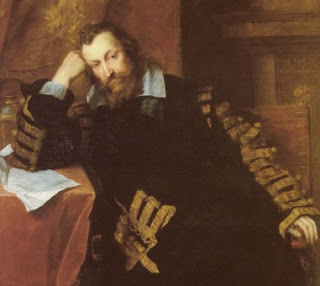
Henry Percy, the 9th Earl of Northumberland AKA "The Wizard Earl" was born on April 27, 1564. His father was also named Henry Percy, but he was the 8th Earl of Northumberland, receiving that title when his brother, the Wizard Earl's uncle, Thomas Percy, 7th Earl of Northumbland was executed in 1572 for his leadership of the Northern Rebellion--and Thomas Percy was beatified by Pope Leo XIII as a martyr! The Wizard Earl's father died in the Tower of London, imprisoned there under suspicion of treason. His grandfather had also run afoul of the Tudor monarch of his era, as Sir Thomas Percy was executed by Henry VIII in 1537 for his involvement in the Pilgrimage of Grace (I'm not sure why he hasn't been beatified as a martyr if his son has been). I think we can see a pattern of trouble in this family's relationship to the Tudors--and it held true for the Wizard Earl during the reign of James I of England.
According to this website:
Henry Percy, the 9th or ‘Wizard’ Earl of Northumberland led an extraordinary life of a true Renaissance nobleman, despite his deafness and 15 years as a prisoner. He was a great scholar, became the patron of the English astronomer Thomas Harriot, the first man to map the surface of the moon before Galileo and earned his nickname ‘Wizard’ by experimenting in alchemy. He was a friend of Sir Walter Raleigh and their interest in the New World led them to consume great quantities of tobacco and potatoes. But it was on 4 November 1605, that the Earl’s fortunes declined literally overnight! A distant cousin, Thomas Percy, who was a staunch Roman Catholic, dined with the Earl at Syon before joining Guy Fawkes and his accomplices the next day, in the attempt to blow up the Houses of Parliament. As one of the principal ‘gunpowder plotters’, Thomas was shot trying to make his escape. Although innocent of the charges brought against him, the Earl was implicated through his association with Thomas and the fateful meeting at Syon. He was confined in the Tower of London for the next 15 years on the orders of King James I.
The 9th Earl was known as the Wizard Earl because of his great interest in science--even in alchemy--and his development of a great library. He was eventually released from the Tower and he died on November 5, 1632. Believe it--or not! Alexander Rose's Kings in the North: The House of Percy in British History tells the story of this family and one reviewer summarized the generations of trouble and adventure they exemplify: Over the past eight centuries, two earls and one duke have been killed in battle, most recently in 1940; one has been lynched by a mob; one beheaded for treason, one shot by government assassins, five incarcerated in the Tower for more or less prolonged periods, and one beatified by the Church of Rome. It is a striking record of public service or disservice, depending on your point of view. The Percys are still the owners of Alnwick Castle and Syon House, and are among the largest landowners in Britain. . . . As soon as the Scottish menace faded in the 16th century, the Percys lost their power. The Tudors no longer needed a viceroy in the north. The sixth earl was ruined by Henry VIII, the seventh executed by Elizabeth, the eighth murdered in the Tower and the ninth abandoned politics for chemistry and astronomy. His successors abandoned the north altogether, and went to live on their Sussex and London estates. The modern fortunes of the family are due to Sir Hugh Smithson, who married the last Percy heiress in the 18th century, adopted her name, and re-established the family as a great northern dynasty.
Published on April 26, 2013 22:30
April 25, 2013
E.I. Watkins, Friend of Christopher Dawson
Sometimes I stumble across something on the web (ouch!)--the other day, after posting on Sir Colin Davis's death, I remembered that Davis had been one of the musicians who signed the letter to Pope Paul VI that led to the "Agatha Christie" indult for the traditional Catholic Mass (now aka the Extraordinary Form of the Latin Liturgy of the Roman Rite). Another name in that list is E.I. Watkin, whose biography was recently issued:
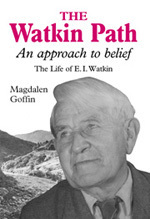 The Watkin Path: An Approach to Belief [by his daughter Magdalen Goffin] is a panorama of twentieth-century social and political history seen through the life of E. I. Watkin (1888–1981). The interplay of love, friction, war, politics and money, together with a relentless search for religious truth, makes this book read more like a novel than a biography.
The Watkin Path: An Approach to Belief [by his daughter Magdalen Goffin] is a panorama of twentieth-century social and political history seen through the life of E. I. Watkin (1888–1981). The interplay of love, friction, war, politics and money, together with a relentless search for religious truth, makes this book read more like a novel than a biography.
Watkin was the only child of Emmeline Paxton Ingram, a daughter of Herbert Ingram, the founder of the Illustrated London News. His father was the nephew of Sir Edward Watkin, the Liberal MP and railway magnate, who started to build the first Channel Tunnel and later a tower to rival Eiffel’s where Wembley Stadium now stands. At birth Watkin was handed over to his Ingram grandmother, an old lady who lived alone in a mansion by the river at Walton-on-Thames. He met few other children, and his strange childhood may account for some of his eccentricities.
Watkin became a Roman Catholic when he was at Oxford. His experience as one of the inner circle of Catholic writers is revealing: He was allowed to publish his books on philosophy, history or literature, but when it came to the interpretation of the Catholic faith he was persistently harassed by the censors. Although Watkin was one of the foremost English precursors of the Second Vatican Council, he deeply deplored some of its consequences.
His extraordinary life experiences were many and varied: from sitting on Mrs Gladstone’s lap at the ceremonial opening of the Watkin Path up Snowdon, to falling instantly in love with Helena Shepheard at a party in 1912, at which point he stopped his diary writing. The story of that marriage, and the Watkin family’s engagement with politicians and theologians about the political and social issues of the time, make for a truly fascinating biography of a most extraordinary man.
At Oxford, Watkin studied at New College (which is actually quite old; founded in 1379, it was called "New College" to distinguish it from the older college at Oxford, Oriel, founded in 1326). Watkin was a mentor to Christopher Dawson in the latter's conversion to Catholicism and worked with Eric Gill and Donald Attwater on the Catholic pacifist movement Pax; additionally, he wrote many books:
Some Thoughts on Catholic Apologetics: A Plea for Interpretation (1915)
A Little Book of Prayers for Peace (1916)
The Philosophy of Mysticism (1920)
The Bow in the Clouds: An Essay Towards the Integration of Experience (1931)
A Philosophy of Form (1935)
Theism, Agnosticism And Atheism (1936)
Men and Tendencies (1937)
The Crime of Conscription (1939)
The Catholic Center (1939)
Catholic Art and Culture (1942)
Praise of Glory (1943)
The Balance of Truth (1943)
Poets and Mystics (1953)
Neglected Saints (1955) -- Ignatius Press reissued this in paperback
Roman Catholicism in England from the Reformation to 1950 (1957)
The Church in Council (1960)
His son was a Benedictine monk, Abbot Aelred Watkin, of Downside Abbey:
Abbot Aelred Watkin was one of the most loved and most respected monks in the Benedictine Order. The two most conspicuous features of his character - a deep spirituality combined with an infectious love of life - are encapsulated in one of his favourite quotations from William Blake: "Everything that lives is holy; life delights in life."
He was born Christopher Ingram Watkin in 1918, the son of a Roman Catholic philosopher and historian, E.I. Watkin, their common middle name perpetuating descent from Herbert Ingram, the founder of the Illustrated London News. His mother, Helen Shepheard, was the daughter of Maria Pasqua, who had been a penniless Italian model until she was adopted by a member of the Baring family, the wealthy Comtesse de Noailles.
 The Watkin Path: An Approach to Belief [by his daughter Magdalen Goffin] is a panorama of twentieth-century social and political history seen through the life of E. I. Watkin (1888–1981). The interplay of love, friction, war, politics and money, together with a relentless search for religious truth, makes this book read more like a novel than a biography.
The Watkin Path: An Approach to Belief [by his daughter Magdalen Goffin] is a panorama of twentieth-century social and political history seen through the life of E. I. Watkin (1888–1981). The interplay of love, friction, war, politics and money, together with a relentless search for religious truth, makes this book read more like a novel than a biography.Watkin was the only child of Emmeline Paxton Ingram, a daughter of Herbert Ingram, the founder of the Illustrated London News. His father was the nephew of Sir Edward Watkin, the Liberal MP and railway magnate, who started to build the first Channel Tunnel and later a tower to rival Eiffel’s where Wembley Stadium now stands. At birth Watkin was handed over to his Ingram grandmother, an old lady who lived alone in a mansion by the river at Walton-on-Thames. He met few other children, and his strange childhood may account for some of his eccentricities.
Watkin became a Roman Catholic when he was at Oxford. His experience as one of the inner circle of Catholic writers is revealing: He was allowed to publish his books on philosophy, history or literature, but when it came to the interpretation of the Catholic faith he was persistently harassed by the censors. Although Watkin was one of the foremost English precursors of the Second Vatican Council, he deeply deplored some of its consequences.
His extraordinary life experiences were many and varied: from sitting on Mrs Gladstone’s lap at the ceremonial opening of the Watkin Path up Snowdon, to falling instantly in love with Helena Shepheard at a party in 1912, at which point he stopped his diary writing. The story of that marriage, and the Watkin family’s engagement with politicians and theologians about the political and social issues of the time, make for a truly fascinating biography of a most extraordinary man.
At Oxford, Watkin studied at New College (which is actually quite old; founded in 1379, it was called "New College" to distinguish it from the older college at Oxford, Oriel, founded in 1326). Watkin was a mentor to Christopher Dawson in the latter's conversion to Catholicism and worked with Eric Gill and Donald Attwater on the Catholic pacifist movement Pax; additionally, he wrote many books:
Some Thoughts on Catholic Apologetics: A Plea for Interpretation (1915)
A Little Book of Prayers for Peace (1916)
The Philosophy of Mysticism (1920)
The Bow in the Clouds: An Essay Towards the Integration of Experience (1931)
A Philosophy of Form (1935)
Theism, Agnosticism And Atheism (1936)
Men and Tendencies (1937)
The Crime of Conscription (1939)
The Catholic Center (1939)
Catholic Art and Culture (1942)
Praise of Glory (1943)
The Balance of Truth (1943)
Poets and Mystics (1953)
Neglected Saints (1955) -- Ignatius Press reissued this in paperback
Roman Catholicism in England from the Reformation to 1950 (1957)
The Church in Council (1960)
His son was a Benedictine monk, Abbot Aelred Watkin, of Downside Abbey:
Abbot Aelred Watkin was one of the most loved and most respected monks in the Benedictine Order. The two most conspicuous features of his character - a deep spirituality combined with an infectious love of life - are encapsulated in one of his favourite quotations from William Blake: "Everything that lives is holy; life delights in life."
He was born Christopher Ingram Watkin in 1918, the son of a Roman Catholic philosopher and historian, E.I. Watkin, their common middle name perpetuating descent from Herbert Ingram, the founder of the Illustrated London News. His mother, Helen Shepheard, was the daughter of Maria Pasqua, who had been a penniless Italian model until she was adopted by a member of the Baring family, the wealthy Comtesse de Noailles.
Published on April 25, 2013 22:30
April 24, 2013
Some "RC" News from England: Marriages, Royal or Not
The Marriage Act of 1753, proposed by Lord Hardwicke, required that for a marriage to be valid, the wedding must take place in the Church of England in a ceremony conducted by a minister of the Church of England. Of course, that caused a great problem for Catholics and Protestant dissenters, although Jews and Quakers were exempted from the Act. The law was passed to prevent clandestine marriages and also required banns be published. This restriction was eventually removed by Parliament in the Marriage Act of 1836 which allowed non-conformists and Catholics to be married in their own places of worship.
According to The Telegraph , recent Parliamentary actions may be undoing the 1836 law:
Prof Christopher McCrudden said that there are serious questions over whether the 120-year-old legal basis on which 8,500 Catholic weddings a year are performed can even “survive” the passage of the bill currently before Parliament.
He told MPs and peers that, unless urgent changes are made, Catholic bishops may have to reconsider whether priests can carry on performing weddings, in effect, on behalf of the state.
The barrister said his advice to senior bishops is that proposed protections for churches against legal challenges under human rights or equalities laws for refusing to marry gay couples completely overlook the position of Catholics and other denominations.
It means that the entire legal basis for Catholic weddings, operating since the late 19th century, could be “unpicked” with “very uncertain consequences”, he warned.
One possible outcome could even be a complete separation of church and civil weddings, such as happens in France where coupes are married in the town hall with a separate service in churches, he said.
On the other hand, the changes in the rules of succession to the throne in England, specifically to allow an heir to the throne to marry a Catholic, have created some concerns:
The Church expects Catholic spouses to do all they can to raise their children as Catholics but does not censure them if they are unable to do so, a Government spokesman has told the House of Lords as it debated changes to the system of Royal succession.
Lord Wallace of Tankerness, speaking on behalf of the Government, said he had been advised on the matter by Mgr Marcus Stock, general secretary of the Bishops’ Conference of England and Wales.
“I have the specific consent of Mgr Stock to say that he was speaking on behalf of Archbishop Nichols as president of the Catholic Bishops’ Conference of England and Wales and can inform the House that the view taken by the Catholic Church in England and Wales is that, in the instance of mixed marriages, the approach of the Catholic Church is pastoral,” he said.
“It will always look to provide guidance that supports and strengthens the unity and indissolubility of the marriage. In this context the Catholic Church expects Catholic spouses to sincerely undertake to do all that they can to raise children in the Catholic Church. Where it has not been possible for the child of a mixed marriage to be brought up as a Catholic, the Catholic parent does not fall subject to the censure of canon law,” Lord Wallace continued.
The remarks were made during the third reading debate of the Succession to the Crown Bill in the House of Lords on Monday.
According to The Telegraph , recent Parliamentary actions may be undoing the 1836 law:
Prof Christopher McCrudden said that there are serious questions over whether the 120-year-old legal basis on which 8,500 Catholic weddings a year are performed can even “survive” the passage of the bill currently before Parliament.
He told MPs and peers that, unless urgent changes are made, Catholic bishops may have to reconsider whether priests can carry on performing weddings, in effect, on behalf of the state.
The barrister said his advice to senior bishops is that proposed protections for churches against legal challenges under human rights or equalities laws for refusing to marry gay couples completely overlook the position of Catholics and other denominations.
It means that the entire legal basis for Catholic weddings, operating since the late 19th century, could be “unpicked” with “very uncertain consequences”, he warned.
One possible outcome could even be a complete separation of church and civil weddings, such as happens in France where coupes are married in the town hall with a separate service in churches, he said.
On the other hand, the changes in the rules of succession to the throne in England, specifically to allow an heir to the throne to marry a Catholic, have created some concerns:
The Church expects Catholic spouses to do all they can to raise their children as Catholics but does not censure them if they are unable to do so, a Government spokesman has told the House of Lords as it debated changes to the system of Royal succession.
Lord Wallace of Tankerness, speaking on behalf of the Government, said he had been advised on the matter by Mgr Marcus Stock, general secretary of the Bishops’ Conference of England and Wales.
“I have the specific consent of Mgr Stock to say that he was speaking on behalf of Archbishop Nichols as president of the Catholic Bishops’ Conference of England and Wales and can inform the House that the view taken by the Catholic Church in England and Wales is that, in the instance of mixed marriages, the approach of the Catholic Church is pastoral,” he said.
“It will always look to provide guidance that supports and strengthens the unity and indissolubility of the marriage. In this context the Catholic Church expects Catholic spouses to sincerely undertake to do all that they can to raise children in the Catholic Church. Where it has not been possible for the child of a mixed marriage to be brought up as a Catholic, the Catholic parent does not fall subject to the censure of canon law,” Lord Wallace continued.
The remarks were made during the third reading debate of the Succession to the Crown Bill in the House of Lords on Monday.
Published on April 24, 2013 22:30
April 23, 2013
Book Review: American Church (pka The Gibbons Legacy) by Russell Shaw
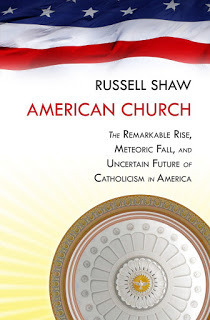 According to the publisher, Ignatius Press:
According to the publisher, Ignatius Press:Has the Americanization of American Catholics--their cultural assimilation, that is--been a blessing or a curse for the Church in the United States? Or has it been a bit of both?
In American Church Russell Shaw takes a searching look at that question and reaches a disturbing conclusion. Cultural assimilation, which was ardently championed by churchmen like the great Cardinal James Gibbons of Baltimore around the turn of the last century, has undoubtedly conferred many benefits on Catholics. Their absorption into the secular culture of America, however, now threatens the Catholic identity of millions of faithful and of their institutions, such as schools, universities, and hospitals.
Shaw does not offer this conclusion as an unsupported generalization. American Church is a richly documented analysis of a process extending over two centuries. Colorful characters and dramatic incidents abound, including the nineteenth-century intellectual feud between Orestes Brownson and the Transcendentalist convert to Catholicism Isaac Hecker, Pope Leo XIII's condemnation of Americanism, the anti-Catholicism that greeted the presidential campaigns of Al Smith and John F. Kennedy, and the numerous intra-Church conflicts that have divided American Catholics since the Second Vatican Council.
In concluding his study, Shaw offers a number of thought-provoking suggestions about what the Church in America needs to do now in the face of an ongoing decline that is sapping its strength and may threaten its very survival.
Russell Shaw is a widely published author and journalist who has written twenty previous books, including To Hunt, To Shoot, To Entertain: Clericalism and the Catholic Laity and Nothing to Hide: Secrecy, Communication, and Communion in the Catholic Church. For 18 years, Shaw directed media relations for the National Conference of Catholic Bishops and the United States Catholic Conference. From 1987 to 1997 he oversaw media relations for the Knights of Columbus. Since resigning from that position, he has worked full time as a freelance writer.
American Church: The Remarkable Rise, Meteoric Fall, and Uncertain Future of Catholicism in America surveys recent history as a personal memoir, analyses the efforts of late nineteenth and early twentieth century Church leaders to chart a path for Catholics in America, and provides some ideas to strengthen Catholic culture in America, ideas which build on movements and efforts already in place. The first several pages of this book presented some confusion as evidently Ignatius Press had changed the title of the book sometime after the text was printed and bound. The original title was "The Gibbons Legacy" and therefore the Foreword by Archbishop Chaput and the Introduction kept mentioning that title. I see that the Kindle edition on amazon.com has cleared up that confusion but it was off putting for a time as I read the paperback edition, which I purchased..
(This is an interesting note for the present and future production of books--the printed and electronic editions can be different: it's much easier to address changes and even corrections in the electronic version. Which one is the official version? Does the Library of Congress decide?)
I presume Ignatius and Shaw changed the title because of concern no one knows who "Gibbons" was--James Cardinal Gibbons, the ninth Archbishop of Baltimore (from 1877 to 1921). Shaw's book comes at a time when others are writing about the renewal of Catholic culture in the U.S., including George Weigel and Ryan N. S. Topping. I have not read those books, so I cannot compare them, but Shaw's book traces the path of assimilation of Catholics in American culture--and as that culture became more and more secularized, then Catholics on that path became more and more secularized. Then he addresses, often from personal experiences, the effects of the implementation of the "spirit of Vatican II", changes in Catholic higher education, reform movements in the episcopacy--and he uses his personal recollections well, without falling into the trap of becoming anecdotal.
On the other hand, I did not think another thread Shaw weaves through the narrative was that effective: he uses the story of The Cardinal, a 1950 novel by Henry Morton Robinson, usually thought to be based on the life of Cardinal Spellman, the Archbishop of New York, as an example of trends and issues in the Catholic Church in America in the early twentienth century. Shaw uses scenes from The Cardinal to exemplify certain changes and events--if you are interested, TCM will be showing the movie based on the novel this summer.
Overall, the story Shaw tells is sad--how the Church lost its influence on American culture because it tried to assimilate too much into American culture. Shaw's hope for the restoration of that influence is in the development of a Catholic subculture, which I think exists--EWTN, Catholic bloggers, the Fellowship of Catholic Scholars, the youthful pro-life movement--and I think will remain small. Primarily, I think Shaw is correct that it is the formation of the laity, as inspired by the documents of the Second Vatican Council that is most important--instead of pursuing "ministries" inside the Church, we should be working to influence our culture--exactly through the sub-culture Shaw outlines. Perhaps the institutional Church should not aspire to the great influence of former days as it may come at the same cost of assimilation or accomodation. Thought-provoking, to say the least.
Published on April 23, 2013 22:30
April 22, 2013
A Telling Detail: St. Thomas More's Chain of Office
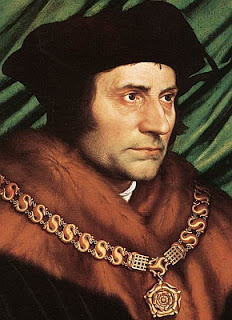 From Peggy Noonan's Wall Street Journal analysis of Margaret Thatcher's funeral comes this telling detail:
From Peggy Noonan's Wall Street Journal analysis of Margaret Thatcher's funeral comes this telling detail:Thatcher's funeral was striking in that it was not, actually, about her. It was about what she thought it important for the mourners to know. The readings were about the fact of God, the gift of Christ, and the necessity of loving your country and working for its betterment. There were no long eulogies. In a friendly and relatively brief address, the bishop of London lauded her kindness and character. No funeral of an American leader would ever be like that: The dead American would be the star, with God in the position of yet another mourner who'd miss his leadership.
The pageantry, for an American, was most moving. The English as always do this brilliantly but I wonder if they understand—they must, but it's not something they acknowledge—that when they bring out and put forward their splendor they are telling the world and themselves who they are and have been. Leading the procession into St. Paul's was the lord mayor of London, in velvet coat, breeches and buckled shoes. On his coat he wore Sir Thomas More's gold chain of office, taken from him before he was killed in the Tower (sic). Imagine a nation that puts such a man to death, contemplates it, concludes in the end it was wrong, and now proudly displays the saint's chain at its greatest events. When I saw it I thought of a recent trip to the Vatican. Touring its archives, we were shown one of its proudest possessions: a letter from Galileo.
Things change. Time changes them. Great nations, and institutions, rethink. But only if they're great.
The chain of office Noonan refers to is the Collar of Esses, which in the detail of the Holbein portrait from this site, you can see is a chain of "S" linked with a Tudor Rose hanging from it. This article has some more detail about the Lord Mayor's Chain of Esses, noting that it is not completely original, and that Henry VIII gave these collars out as rewards for faithful service:
The merciless punishments Henry VIII meted out to his enemies have been well documented. Less is known about how, on the rarer occasions when the king was happy with the service of his courtiers or the country's most eminent noblemen, he liked to give them a golden livery collar or heavy chain as a token of his gratitude.
Henry VIII only awarded around 20 of the chains. They were all engraved with the characters SS, referring to the Latin religious creed, Spiritus Sanctus (Holy Spirit), though none were believed to have survived in their entirety. [I'm not sure what the author is refering to here--the Holy Spirit is the Third Person of the Holy Trinity; Spiritus Sanctus is just the Latin for Holy Spirit.]
Now, however, the first complete "collar of the Esses", as they were known, has been discovered in the family home of the Romantic poet Samuel Taylor Coleridge. The collar was presented to Edward Montagu, the then Lord Chief Justice, by King Henry in the 1540s.
It is understood that the extraordinary find is to be sold in December at Christie's auction house in London, where it is expected to fetch up to £1m.
The only other Esses collar known to be in existence, which is owned by the Lord Mayor of London, is believed to contain just 20 per cent of the original craftmanship, while the new discovery has much more of its original design intact.
A number of silver collars of the Esses, which were handed out to queens and courtiers, survive today, including one on display at the Victoria and Albert Museum. But a gold version of the livery chain was far rarer to behold in Henry VIII's day.
The gold collar famously features in the portrait of Sir Thomas More painted by Hans Holbein, which was used as a background for credits in the television series, The Tudors.
Although the English nation may regret the execution of Sir Thomas More, we know that it has had greater difficulty with acknowledging the truth about the English Reformation--that's been a regular theme of this blog and my book, Supremacy and Survival: How Catholics Endured the English Reformation. As recently as last year, Eamon Duffy stated:
For five centuries England has been in denial about the role of Roman Catholicism in shaping it. The coin in your pocket declares the monarch to be Defender of the Faith. Since 1558 that has meant the Protestant faith, but Henry VIII actually got the title from the Pope for defending Catholicism against Luther. Henry eventually broke with Rome because the Pope refused him a divorce, and along with the papacy went saints, pilgrimage, the monastic life, eventually even the Mass itself – the pillars of medieval Christianity.
To explain that revolution, the Protestant reformers told a story. Henry had rejected not the Catholic Church, but a corrupt pseudo-Christianity which had led the world astray. John Foxe embodied this story unforgettably in his Book of Martyrs, subsidised by the Elizabethan government as propaganda against Catholicism at home and abroad. For Foxe, Queen Elizabeth was her country’s saviour, and the Reformation itself the climax of an age-old struggle between God, represented by the monarch, and the devil, represented by the Pope. . . .
It is time to look again at the Reformation story. There was nothing inevitable about the Reformation. The heir to the throne is uneasy about swearing to uphold the Protestant faith, and it seems less obvious than it once did that the religion which gave us the Wilton Diptych and Westminster Abbey, or the music of Tallis, Byrd and Elgar, is intrinsically un-English. The destruction of the monasteries and most of the libraries, music and art of medieval England now looks what it always was – not a religious breakthrough, but a cultural calamity.
How a nation deals with its past, especially the dark periods of its past, is, as Noonan indicates, an important test of its honesty and humility. The United States certainly has periods it has to deal with honestly and forthrightly, and England, like any other nation, has others to deal with other than the English Reformation. Perhaps this detail of Sir Thomas More's Chain of Esses--which was not really taken from him, but which he surrendered upon his resignation as Lord Chancellor, when he saw the dark era England was about to enter--could be a sign that England has faced the injustice of his execution and acknowledged it. Let's hope so!
Published on April 22, 2013 22:30
April 21, 2013
Walsingham and Newman in Kansas City!
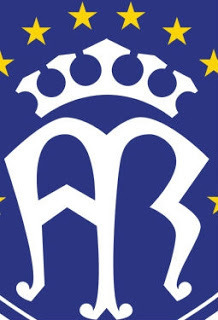 Everything's up to date in Kansas City! Including this great news from the
National Catholic Register
:
Everything's up to date in Kansas City! Including this great news from the
National Catholic Register
:KANSAS CITY, Mo. — The Diocese of Kansas City-St. Joseph, Mo., is set to become the home of Christ College, a new Catholic liberal arts school inspired by the thought of Blessed John Henry Newman.
“He’s really the guiding intellectual light of what we’re trying to do,” Brinton Smith, president of the Walsingham Society of Christian Culture and Western Civilization, told EWTN News on April 17.
“His work has been an inspiration, and we look to his The Idea of a University as one of our primary texts, in how we see things and what we’d like to accomplish as a Catholic liberal arts college.”
Christ College is a project of the Walsingham Society, which is based in Dallas. The college plans to lease space at the diocesan chancery in Kansas City, Mo., and begin with a pilot program this fall.
The pilot program would include a few courses, starting with Latin and theology, Smith said, and would be followed with the full curriculum being introduced to the freshman class in the fall of 2014.
Smith met the diocesan chancellor, Jude Huntz, at a conference on Anglicans who had converted to Catholicism. Huntz was enthusiastic about the prospect of a liberal arts college and introduced Smith to Bishop Robert Finn.

The mission of The Walsingham Society, which is NOT named for Francis Walsingham, Elizabeth I's spymaster, but for Our Lady of Walsingham, is:
to cultivate the minds and improve the lives and communities of its members through guided critical reading and discussion of the perennial truths found within the great books of the Western intellectual tradition. The canon of texts explored in our lectures, seminars, and tutorials resides within the disciplines of theology, philosophy, literature, music, art, and classical languages, each of which contains its own distinct mode of vision and knowing. The vision and knowledge of the great poets, scholars, and artists of the West provide foundational insights into beauty, goodness, and truth that are studied with love and passed down from tutor to student in a learning environment that is leisurely yet exhaustive.
THE WALSINGHAM SOCIETY has its mission the representation, on behalf of the great intellectual and imaginal tradition that has formed the Christian West, of those things true, beautiful, and good in a culture that accepts that truth is unknowable, beauty an illusion, and the pursuit of goodness an offense to the existing moral pluralism. The mission of the Society is rooted in an understanding of the nature and purpose of every person, which at its highest is to love and to enjoy as well to endure.
THE MOTTO of the Society is Caritas cum Consilio, Love with Understanding. The programs of the Society are based upon the conviction that the most important thing in this world is a person, hoping for goodness, seeking fulfillment according to the way he or she has been given. The Society’s success is measured by its ability to lift up the eye of the heart of those who share this adventure with us to the world of significance that lies beyond utility, in the precincts of truth, giving them access to the great tradition through the Great Books, and also through the art and music that is collateral to it.
As you might expect, according to the same National Catholic Register article linked above, "Many of the society’s members are Catholic converts from Episcopalianism and attend Masses of Anglican use or through the Ordinariate of the Chair of St. Peter." The college in Kansas City will begin with Latin and theology as a pilot program and then blossom into the full Liberal Arts curriculum in the fall of 2014. Sounds like a great idea of a university!
Published on April 21, 2013 22:30
April 20, 2013
Regine Pernoud Would Agree!
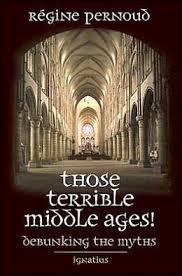 Regine Pernoud wrote the book shown above, published by Ignatius Press and translated by Anne Englund Nash, and she would agree with Stephen Cooper, who "argues that we should resist using ‘medieval’ as another word for backward." He goes on to outline what we should know about the medieval period, especially the 15th century, in his article titled "Positively Medieval" in
History Today
:
Regine Pernoud wrote the book shown above, published by Ignatius Press and translated by Anne Englund Nash, and she would agree with Stephen Cooper, who "argues that we should resist using ‘medieval’ as another word for backward." He goes on to outline what we should know about the medieval period, especially the 15th century, in his article titled "Positively Medieval" in
History Today
:The work of the late Dom David Knowles showed that monasticism was far from corrupt and decadent, although the heroism and austerity of the High Middle Ages may have been lost. Eamon Duffy has demonstrated that religion was thriving at parish level. In The Practice of Kingship Jeremy Catto argues that most 15th-century bishops were graduates, learned men who were both efficient administrators and conscientious diocesans. As for the origins of Protestantism, McFarlane was sceptical that these were to be found in the Lollard heresy. He showed that this had been rooted out of Oxford and respectable society by the time of the Lollard rebellion known as Oldcastle’s Revolt (1414). It survived, though tenaciously, among country ‘bumpkins’ only. By implication the origins of the Reformation lay not in the decline of the medieval Church but in the difficult family life of Henry VIII.
We can see for ourselves, in the glories of Perpendicular architecture in the parish churches, cathedrals, the abbeys, chantry chapels and collegiate churches and in the colleges of Oxford and Cambridge, that the Church was by no means in decline in the 15th century. On the contrary, there was a flowering of piety, especially lay piety. Men were building and re-building to the glory of God and for the benefit of their souls, right down to the Reformation. What changed, when that came, was doctrine and fashion. The abbeys and the chantries were torn down because men had ceased to believe in the notion of Purgatory, at least officially, though their late medieval ancestors (apart from the Lollards) had taken this so seriously.
In secular architecture it was traditionally the Tudor period that saw the transition from castle to manor house; W.G. Hoskins popularised the idea of a ‘Great Rebuilding’ of more humble dwellings between 1550 and 1640. Yet this does not mean that there was no rebuilding in the 15th century. A later building may obscure an earlier one. Take Richard Beauchamp, 13th Earl of Warwick (1382-1439), father-in-law of that quintessential ‘medieval’ figure, Warwick the Kingmaker. He built or rebuilt castles and manor houses at Warwick, Hanley, Drayton Basset, Elmsley, Caversham and Hanslope and, when he died in 1439, he was buried in a magnificent tomb in St Mary’s Church in Warwick. This has a bronze effigy and weepers, the work of a Flemish master, just as beautiful and impressive as the much better known ‘Renaissance’ effigy of Henry VII by Torrigiano in Westminster Abbey. Yet, according to traditional chronology, Warwick is a ‘medieval’ figure, while Henry VII is ‘early modern’. In fact, there are wonderful 15th-century timber and plaster buildings everywhere one looks in England, but we have become accustomed to describe these as ‘Tudor’.
In literature, we have been taught that Geoffrey Chaucer (c.1343-1400) was a genius, but John Lydgate (c.1370-c.1451) was a dunce; and that the whole of the 15th century, at least before the advent of the printing press, was a fallow period. Yet in his own day men enjoyed Lydgate and rated him. Henry V and his brothers, Bedford and Gloucester, were all bibliophiles; and there is a good case for saying that English Humanism began in the 15th, rather than in the 16th, century (see Daniel Wakelin’s Humanism, Reading and English Literature 1450-1530). In law, we have been taught to think that ‘medieval’ means backward and ‘modern’ means advanced; but it is in the works of Sir John Fortescue (c.1394-1476) that we find the classic statement that torture is contrary to the common law of England, while in the 17th century the state used it routinely, at least so far as Catholic conspirators were concerned.
"We were taught," "we have been taught"--when Cooper uses such phrases in the article, the traditional Whig is being knocked askew yet again. That old Whig view, espoused by historians like David Hume and James Froude in Scotland and England, and adopted by the Enlightenment philosophes of France, that the Middle Ages were the Dark Ages, worthy of nothing but ridicule, avoided by historians because of their superstition, papistry, and obscurity--it's still with us today. Think of William Manchester's A World Lit Only by Fire, which even Thomas Cahill notes is filled with Anti-Catholic prejudice and "one howler after another" (see Cahill's Mysteries of the Middle Ages, which demonstrates some of his own unexamined prejudies with a ridiculous emphasis on attacking George W. Bush and promoting "Voice of the Faithful" and "Call to Action").
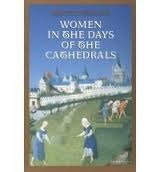 Pernoud's slender volume is filled with almost Chestertonian paradoxes: one of the most memorable to me now is that she contrasts medieval Gothic and renaissance Classicism in architecture by noting that the architects, even though anonymous in the Middle Ages, innovated in developing the soaring perpendicular Gothic cathedrals: renaissance architects copied the architecture of Greece and Rome. I enjoyed Pernoud's debunking of the myths (the same myths Manchester repeated and Cahill regretted); I enjoyed her book on Women in the Age of the Cathedrals even more.
Pernoud's slender volume is filled with almost Chestertonian paradoxes: one of the most memorable to me now is that she contrasts medieval Gothic and renaissance Classicism in architecture by noting that the architects, even though anonymous in the Middle Ages, innovated in developing the soaring perpendicular Gothic cathedrals: renaissance architects copied the architecture of Greece and Rome. I enjoyed Pernoud's debunking of the myths (the same myths Manchester repeated and Cahill regretted); I enjoyed her book on Women in the Age of the Cathedrals even more. I was reading it on an airplane years ago, and another (female) passenger expressed some deprecatory interest--"I expect there's not much to say about women in those days, since we were so oppressed". You might anticipate my reply (but I'll tell you anyway)--"Au contraire; you should read Pernoud's book: you would discover how much economic and intellectual freedom women had in the Middle Ages!" I doubt she read the book, don't you?. Someday, I hope these old Whig ideas will be completely debunked and exposed, but it will take a long time for the easy prejudgements Pernod describes in Those Terrible Middle Ages and I experienced in the late twentieth century to be replaced by more thoughtful appreciation of an essential period of European history.
Published on April 20, 2013 22:30
April 19, 2013
April 20th in 1534, 1584, 1586, and 1602
 A digest of last year's posts on this date:
A digest of last year's posts on this date:On April 20, 1534, Elizabeth Barton, the Nun of Kent, was executed at Tyburn, London, along with monks and priests named as her co-conspirators.
In Father Philip Hughes' A Popular History of the Reformation, he provides an excellent chronological narrative of events, describing the influence of the Lutheran Reformation in England before Henry VIII's Break from Rome. He then traces the events leading up to the Break, the Reformation Parliament and "the deed of blood" that was a turning point:
The deed of blood was the condemnation by attainder (i.e., by an act of Parliament, without any trial) and the execution at Tyburn of "the Nun of Kent" and four priests condemned as her accomplices. "We now enter on a period which is happily unique in the annals of England, a period of terror. It lasts from [1534 to 1540]. --quoting H.A.L. Fisher's History of England from the Accession of Henry VII to the Death of Henry VIII (1918).
I was impressed by the quotation Father Hughes selected and the use of the term "period of terror" like the Reign of Terror of the French Revolution. As Father Hughes goes on to comment by April 20, 1534 Sir Thomas More and John Fisher, Bishop of Rochester are imprisoned--even though they escaped being included in the attainder because of their contact with Elizabeth Barton.
Blessed James Bell and Blessed John Finch were martyred in Lancaster on April 20, 1584:
When condemned and sentenced Blessed James Bell said to the Judge: "I beg your Lordship would add to the sentence that my lips and the tops of my fingers may be cut off, for having sworn and subscribed to the articles of heretics contrary both to my conscience and to God's Truth"--because he had conformed to the Church of England for a time. The priest was hung, drawn, and quartered, while the layman Finch was hung to death. They were both beatified by Pope Pius XI in 1929.
Blessed Richard Sargent and Blessed William Thomson both have a connection to St. Anne Line, and were both hung, drawn, and quartered at Tyburn in London on April 20, 1586--they are among the 85 Martyrs of England and Wales beatified by Blessed Pope John Paul II in 1987.
Blessed Thomas Tichborne, Blessed Robert Watkinson, and Blessed Francis Page (another connection to St. Anne Line, as he was the priest ready to celebrate Mass when pursuivants broke into the safe house Anne Line managed for Father John Gerard, SJ) were all executed at Tyburn on April 20, 1602. They also were beatified in 1987.
I don't know what overall significance we should ascribe to this coincidence that seven beatified martyrs and six attainted conspirators against the monarch's religious and marital policies all died on April 20 in four different years. The links among St. Anne Line, Blessed Francis Page, Blessed Richard Sargent, and Blessed William Thomson certainly make sense: the recusant Catholic community was small and connected through the underground system of safe houses, etc.
Published on April 19, 2013 22:30
April 17, 2013
Sir Colin Davis, RIP
Before the English Reformation and the Catholic Martyrs of England and Wales became my main focus of attention, classical music and opera were my passions. The death of Sir Colin Davis on Sunday, April 14, really struck me, primarily because he conducted two of my favorite recordings--two very different works:
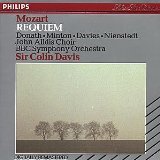
This Philips Silver Line recording of Mozart's Requiem is a great performance of this unfinished work (the Sussmayer edition). The BBC Symphony Orchestra, John Alldis Choir, and the soloists, including Helen Donath, all follow Davis's lead in this dynamic, dramatic, and grand performance. Some of the sections of the Dies Irae--the Lacrimosa, the Rex Tremendae, the Confutatis, are just brilliantly exciting and moving. Davis makes the contrasts of the Day of Wrath completely evident.
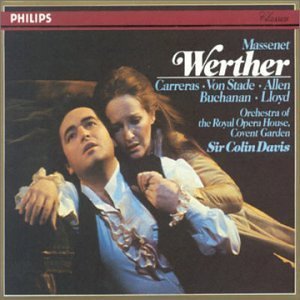
I have listened to this 1980 opera recording of Von Stade and Carreras so often that I've nearly memorized it. It was made after performances at the Royal Opera House, Covent Garden and that stage background shows in the drama and passion, restraint and lyricism of von Stade's performance especially. She is certainly not Goethe's Lotte, cutting bread as Werther's body passes. After all the romanticism and restraint of Acts 1 through 3 (even with Charlotte's break down aria, "Va! laisse couler mes larmes"), Davis, Von Stade, and Carreras certainly help us suspend our disbelief that a man who just shot himself can sing for 15 minutes! (You can see Von Stade and Alfredo Kraus in this video from the Met in 1988 just to see how it's done onstage.)
May Sir Colin Davis rest in peace.

This Philips Silver Line recording of Mozart's Requiem is a great performance of this unfinished work (the Sussmayer edition). The BBC Symphony Orchestra, John Alldis Choir, and the soloists, including Helen Donath, all follow Davis's lead in this dynamic, dramatic, and grand performance. Some of the sections of the Dies Irae--the Lacrimosa, the Rex Tremendae, the Confutatis, are just brilliantly exciting and moving. Davis makes the contrasts of the Day of Wrath completely evident.

I have listened to this 1980 opera recording of Von Stade and Carreras so often that I've nearly memorized it. It was made after performances at the Royal Opera House, Covent Garden and that stage background shows in the drama and passion, restraint and lyricism of von Stade's performance especially. She is certainly not Goethe's Lotte, cutting bread as Werther's body passes. After all the romanticism and restraint of Acts 1 through 3 (even with Charlotte's break down aria, "Va! laisse couler mes larmes"), Davis, Von Stade, and Carreras certainly help us suspend our disbelief that a man who just shot himself can sing for 15 minutes! (You can see Von Stade and Alfredo Kraus in this video from the Met in 1988 just to see how it's done onstage.)
May Sir Colin Davis rest in peace.
Published on April 17, 2013 22:30
April 16, 2013
Lady Margaret Thatcher, RIP
Paul Kengor writes about the Iron Lady, Lady Thatcher in The Catholic World Report:
Margaret Thatcher, one of the greatest leaders of the Cold War, of the 20th century, and of British history, has died at the age of 87.
I’ve referred to her as one of my Cold War seven: Ronald Reagan, John Paul II, Mikhail Gorbachev, Lech Walesa, Vaclav Havel, Boris Yeltsin, and Margaret Thatcher. They were the seven figures who dissolved an Evil Empire, and only Walesa and Gorbachev still remain with us.The world dubbed her the Iron Lady, a title that duly fits. Many, however, mistake the Iron Lady moniker as referring solely to her strength in the Cold War. There was much more to it. Consider:
Margaret Thatcher is arguably the most complete British leader of the last 100 years, surpassing even Winston Churchill. Like Churchill, she was tough and successful in foreign policy, taking on and vanquishing totalitarian evil. Churchill warned the world as the Iron Curtain descended across Europe. Decades later, the world celebrated as the Iron Lady helped break the Iron Curtain.
But unlike Churchill, Margaret Thatcher had enormous domestic successes that Churchill couldn’t touch, and didn’t dare try to touch. When World War II closed, the British people booted Churchill from the prime ministership in preference of Labour leader Clement Attlee, who gave the British populace Keynesian socialism. The masses wanted their welfare state, and Attlee, equipped with promises of “change” and “forward,” gave them a fundamental transformation. In no time, Attlee’s party was spending money unlike anything Britain had ever seen, nationalizing everything under the sun, including with the progressive left’s coup de grace: government healthcare. It was a giant government binge that would bury Britain for decades.
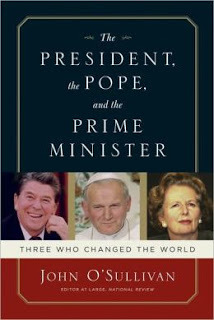
John O'Sullivan titled his 2006 book about the triumvirate of Reagan, Thatcher and Pope John Paul II, The President, the Pope, and the Prime Minister: Three Who Changed the World. The American Spectator has this 2007 review in its archives:
OTHER WRITERS HAVE NOTED the timely emergence of an American president, a Polish pope, and a British prime minister in the late 1970s and early 1980s and their critical role in leading the West to a peaceful resolution of the Cold War. But it has remained for the Anglo-American journalist and editor John O’Sullivan to write the definitive history of how Ronald Reagan, Pope John Paul II, and Margaret Thatcher worked together, openly and not so openly, to bring about what most experts agreed was impossible — the swift dissolution of the Soviet Union and Marxism-Leninism.
To write such a multi-faceted story, you would want a polymath: an American familiar with Reagan’s special genius for combining principle and pragmatism, a Brit who could explain how Thatcher became the first woman prime minister in British history, and a Roman Catholic who understood why the Soviets were so worried about the impact of a Polish pope on their empire. You would seek someone with a keen historical sense and a flair for biography — and the ability to integrate smoothly the myriad accomplishments of three major figures of our times. If this paragon also had a smooth, accessible writing style, that would be a heaven-sent bonus. It would be impossible, of course, to find someone who could do all of the above-unless you could persuade John O’Sullivan to write The President, the Pope, and the Prime Minister, his first but not I hope last book.
O’Sullivan begins his admirable study by making the arresting point that the times seemed to have by-passed Reagan, Thatcher, and Karol Wojtyla, who embodied such seemingly “fading” virtues as faith, self-reliance, and patriotism. But the unexpected death of the Italian John Paul I led to the election of the Polish John Paul II in 1978; Jimmy Carter’s monumental ineptitude at home and abroad prepared the way for a conservative alternative in Reagan in 1980; and Britain’s accelerating economic decline coupled with a series of often violent strikes in the winter of 1978-79 brought the country to the edge of anarchy. Thatcher offered a strong purgative — economic liberty, traditional Christian values, patriotism, and a strong attachment to the United States and like-minded nations — and in May 1979 was elected prime minister. . .
In summing up the individual and collective achievements of the president, the pope, and the prime minister, O’Sullivan states that Reagan won the Cold War without firing a shot; revived the U.S. economy, which went on to enjoy more than 20 years of consecutive economic growth; restored the spirit of America; and established a “new conservative dominance in American politics” based on small government and low taxes.
John Paul II, besides helping bring down the Soviet empire, bequeathed to Pope Benedict XVI a Catholic Church that was large, growing fast (particularly in the Third World), and becoming more orthodox. According to O’Sullivan, Thatcher’s reputation is higher in the rest of the world than in Britain, but even in her native land the Iron Lady’s policies that defeated inflation, restored British industry, and helped win the Cold War are “almost universally regarded as correct.” Still she bears the burden of the vehement opposition and even hatred they aroused, especially among the liberal intelligentsia.
I heard an interview with O'Sullivan on the Son Rise Morning Show yesterday, and he emphasized that President Reagan was the link between Pope John Paul II and Prime Minister Thatcher: she did not deal as directly, or as often with the Pope as Reagan did. He also commented that Lady Thatcher was an Anglican much influenced by Methodism, in which she was raised. In 1978, Lady Thatcher talked to the editor of The Catholic Herald about her religious practice:
“Methodism isn’t just a religion for Sundays – no faith is only a faith for Sundays. There were a lot of things during the week which one attended. Methodism is a pretty practical faith; there were the mothers’ sewing meetings and the guilds for young people.
“It’s also evangelical, and does a lot of missionary work overseas. The visiting missionaries, some of them from South America, some from Africa and India, would come back and tell you of the kind of work they were doing.
“I must say I was very much attracted to the work they did because they really could see results.”
Although she was married to Denis Thatcher 27 years ago in Wesley’s own chapel in the City of London, she has since moved towards Anglicanism and I asked her about this shift.
“You know, John Wesley would of course say that he was a member of the Church of England, and the service he believed in was the Church of England service; but it was too high for the kind of evangelical work he was doing.
“Methodism is the most marvellous evangelical faith and there is the most marvellous love and feeling for music in the Methodist Church which I think is greater than in the Anglican Church. But you sometimes feel the need for a slightly more formal service and perhaps a little bit more formality in the underlying theology too.
“So throughout my life I have felt the need for both things, to some extent for the informality, for the works you do; but always I found myself groping out for more of the actual teaching of the religious basis. As I say, I went for something a little more formal. I suppose it’s first one’s belief and then one’s background.”
May she rest in peace.
Margaret Thatcher, one of the greatest leaders of the Cold War, of the 20th century, and of British history, has died at the age of 87.
I’ve referred to her as one of my Cold War seven: Ronald Reagan, John Paul II, Mikhail Gorbachev, Lech Walesa, Vaclav Havel, Boris Yeltsin, and Margaret Thatcher. They were the seven figures who dissolved an Evil Empire, and only Walesa and Gorbachev still remain with us.The world dubbed her the Iron Lady, a title that duly fits. Many, however, mistake the Iron Lady moniker as referring solely to her strength in the Cold War. There was much more to it. Consider:
Margaret Thatcher is arguably the most complete British leader of the last 100 years, surpassing even Winston Churchill. Like Churchill, she was tough and successful in foreign policy, taking on and vanquishing totalitarian evil. Churchill warned the world as the Iron Curtain descended across Europe. Decades later, the world celebrated as the Iron Lady helped break the Iron Curtain.
But unlike Churchill, Margaret Thatcher had enormous domestic successes that Churchill couldn’t touch, and didn’t dare try to touch. When World War II closed, the British people booted Churchill from the prime ministership in preference of Labour leader Clement Attlee, who gave the British populace Keynesian socialism. The masses wanted their welfare state, and Attlee, equipped with promises of “change” and “forward,” gave them a fundamental transformation. In no time, Attlee’s party was spending money unlike anything Britain had ever seen, nationalizing everything under the sun, including with the progressive left’s coup de grace: government healthcare. It was a giant government binge that would bury Britain for decades.

John O'Sullivan titled his 2006 book about the triumvirate of Reagan, Thatcher and Pope John Paul II, The President, the Pope, and the Prime Minister: Three Who Changed the World. The American Spectator has this 2007 review in its archives:
OTHER WRITERS HAVE NOTED the timely emergence of an American president, a Polish pope, and a British prime minister in the late 1970s and early 1980s and their critical role in leading the West to a peaceful resolution of the Cold War. But it has remained for the Anglo-American journalist and editor John O’Sullivan to write the definitive history of how Ronald Reagan, Pope John Paul II, and Margaret Thatcher worked together, openly and not so openly, to bring about what most experts agreed was impossible — the swift dissolution of the Soviet Union and Marxism-Leninism.
To write such a multi-faceted story, you would want a polymath: an American familiar with Reagan’s special genius for combining principle and pragmatism, a Brit who could explain how Thatcher became the first woman prime minister in British history, and a Roman Catholic who understood why the Soviets were so worried about the impact of a Polish pope on their empire. You would seek someone with a keen historical sense and a flair for biography — and the ability to integrate smoothly the myriad accomplishments of three major figures of our times. If this paragon also had a smooth, accessible writing style, that would be a heaven-sent bonus. It would be impossible, of course, to find someone who could do all of the above-unless you could persuade John O’Sullivan to write The President, the Pope, and the Prime Minister, his first but not I hope last book.
O’Sullivan begins his admirable study by making the arresting point that the times seemed to have by-passed Reagan, Thatcher, and Karol Wojtyla, who embodied such seemingly “fading” virtues as faith, self-reliance, and patriotism. But the unexpected death of the Italian John Paul I led to the election of the Polish John Paul II in 1978; Jimmy Carter’s monumental ineptitude at home and abroad prepared the way for a conservative alternative in Reagan in 1980; and Britain’s accelerating economic decline coupled with a series of often violent strikes in the winter of 1978-79 brought the country to the edge of anarchy. Thatcher offered a strong purgative — economic liberty, traditional Christian values, patriotism, and a strong attachment to the United States and like-minded nations — and in May 1979 was elected prime minister. . .
In summing up the individual and collective achievements of the president, the pope, and the prime minister, O’Sullivan states that Reagan won the Cold War without firing a shot; revived the U.S. economy, which went on to enjoy more than 20 years of consecutive economic growth; restored the spirit of America; and established a “new conservative dominance in American politics” based on small government and low taxes.
John Paul II, besides helping bring down the Soviet empire, bequeathed to Pope Benedict XVI a Catholic Church that was large, growing fast (particularly in the Third World), and becoming more orthodox. According to O’Sullivan, Thatcher’s reputation is higher in the rest of the world than in Britain, but even in her native land the Iron Lady’s policies that defeated inflation, restored British industry, and helped win the Cold War are “almost universally regarded as correct.” Still she bears the burden of the vehement opposition and even hatred they aroused, especially among the liberal intelligentsia.
I heard an interview with O'Sullivan on the Son Rise Morning Show yesterday, and he emphasized that President Reagan was the link between Pope John Paul II and Prime Minister Thatcher: she did not deal as directly, or as often with the Pope as Reagan did. He also commented that Lady Thatcher was an Anglican much influenced by Methodism, in which she was raised. In 1978, Lady Thatcher talked to the editor of The Catholic Herald about her religious practice:
“Methodism isn’t just a religion for Sundays – no faith is only a faith for Sundays. There were a lot of things during the week which one attended. Methodism is a pretty practical faith; there were the mothers’ sewing meetings and the guilds for young people.
“It’s also evangelical, and does a lot of missionary work overseas. The visiting missionaries, some of them from South America, some from Africa and India, would come back and tell you of the kind of work they were doing.
“I must say I was very much attracted to the work they did because they really could see results.”
Although she was married to Denis Thatcher 27 years ago in Wesley’s own chapel in the City of London, she has since moved towards Anglicanism and I asked her about this shift.
“You know, John Wesley would of course say that he was a member of the Church of England, and the service he believed in was the Church of England service; but it was too high for the kind of evangelical work he was doing.
“Methodism is the most marvellous evangelical faith and there is the most marvellous love and feeling for music in the Methodist Church which I think is greater than in the Anglican Church. But you sometimes feel the need for a slightly more formal service and perhaps a little bit more formality in the underlying theology too.
“So throughout my life I have felt the need for both things, to some extent for the informality, for the works you do; but always I found myself groping out for more of the actual teaching of the religious basis. As I say, I went for something a little more formal. I suppose it’s first one’s belief and then one’s background.”
May she rest in peace.
Published on April 16, 2013 22:30



